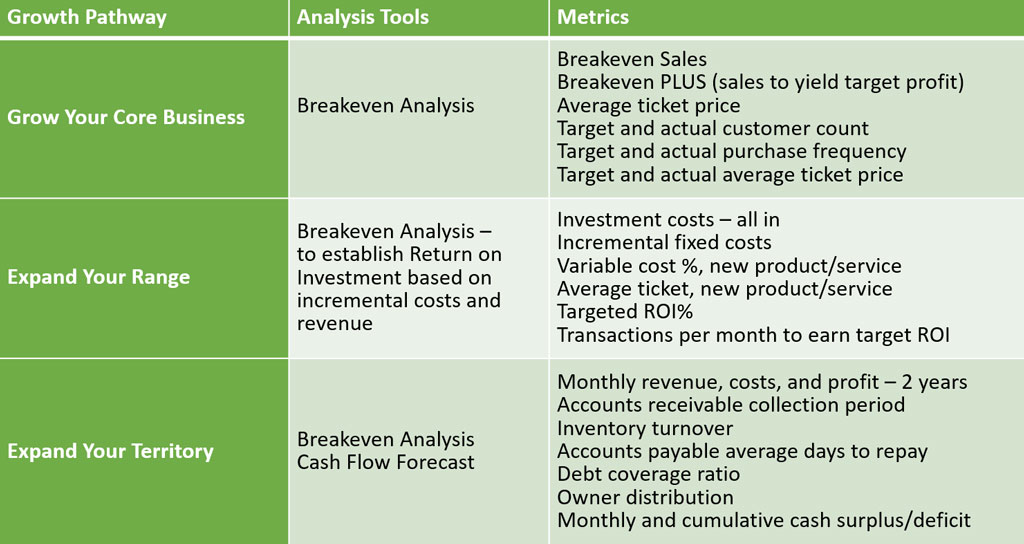Blueprint for Growth, Part 1: Grow your core business

This is the first of a three-part series called “Blueprint for Growth.” In this first column I outline three growth options and then focus on Option 1: Grow Your Core Business. In my next column, I will focus on Option 2: Expand Your Range of Services, and finish with Option 3: Expand Your Territory.
There is no greater loss than opportunity left uncapitalized. Do you have a long-term plan for maximizing your profit potential by taking advantage of every opportunity for growth? Is each growth strategy fully developed with measurable goals for activities that, if achieved, would yield the results you seek? Does the math pencil out?
An actionable blueprint for growth outlines the financial metrics and business milestones required to accelerate profitable growth through some combination of these possible strategies:
1) Growing your core business (organic growth; same services, same territory)
2) Expanding your range (more products and services, same territory)
3) Expanding your territory (add a location to extend geographic reach)
Do the math!
To set actionable goals and measurable milestones for each strategy, you must do the math. If you’re a numbers person, you are saying “Yes! This is in my comfort zone.” If instead you’re saying, “I don’t like numbers,” learn to use some basic business analysis tools to outline your pathway to success. Here is a snapshot of the financial foundations for your blueprint for growth.

Grow your core business
In this article I share my perspective on the first strategy, Grow Your Core Business. In subsequent columns, you’ll find detailed perspectives related to expanding your range of products and services, or expanding your geographic territory.
What is your core business? Caring for seniors at home or fur babies at your facility? Providing tonight’s dinner curbside? Whatever it is, your first growth opportunity is to do more of it as efficiently as possible. How much more? Do the math.
What sales are required to reach breakeven (milepost one) and what sales would yield the return required to meet your investment goals (milepost two, which we call Breakeven PLUS)? With a basic understanding of your cost structure, breakeven analysis will reveal the sales goals that serve as your mileposts. Unfortunately, you can’t manage sales. You can only manage the activities that drive sales.
To make your sales goal actionable, establish targets for three sales drivers (leading indicators): 1) How many customers? 2) Buying at what frequency? 3) At what average ticket price?
You’ll need goals and strategies for all three. Use past customer data for your location or franchise system as benchmarks, and set actionable targets to keep you focused on these leading indicators of growth. If you know your lead conversion rate, you could work backward to determine the number of leads needed to acquire the targeted new customers. You could even use your cost per lead to set a marketing budget. The process provides measurable goals that keep your entire team on track. There are no shortcuts. You must do the math!
How can franchisors help?
Every franchisor should have a strong infrastructure for supporting franchisees to grow their core business. POS or CRM systems should track and report the leading indicators of success. And there’s more…
- Recommend a sensible chart of accounts. Enable tracking of variable costs separate from fixed costs. This typically requires tracking different types of payroll separately. For example, direct labor is usually a variable cost, while sales and administrative payroll are typically fixed. If the chart of accounts provides only one bucket for payroll, it’s difficult to assess the cost structure, i.e., the true variable cost percentage and average monthly fixed costs.
- Provide financial education. Provide knowledge, financial skills, and tools. Ensure franchisees have numbers they can trust, and that they know how to use financial information to make better, more profitable decisions. This includes a solid understanding of the many uses of breakeven analysis—an essential skill for every business owner and franchise business consultant. Check out our website for a quick-start, scalable solution to get your team on the right financial track.
- Benchmark your KPIs. Collect, analyze, and share information that demonstrates what “good” (and achievable) performance looks like at various phases of unit maturity. Benchmark sales, productivity, and profitability metrics as well as risk, debt service, and cash flow ratios. With these points of reference, franchisees can construct reliable plans and obtain the financing they need to succeed.
Conclusion
You wouldn’t build a house without a blueprint, and you shouldn’t attempt to build a business without one either. Be the architect of your future by creating your own blueprint outlining the financial foundations for growing your core business.
Next time I will detail the blueprint for growth when expanding your range of products and services.
Barbara Nuss is the president and founder of Profit Soup, a financial education organization specializing in providing services to franchisors and franchisees to enable them to trust their numbers, focus on priorities, make better decisions, and earn more profit. Learn more at www.profitsoup.com or call 206-282-3888.
Share this Feature
Recommended Reading:
FRANCHISE TOPICS
- Multi-Unit Franchising
- Get Started in Franchising
- Franchise Growth
- Franchise Operations
- Open New Units
- Franchise Leadership
- Franchise Marketing
- Technology
- Franchise Law
- Franchise Awards
- Franchise Rankings
- Franchise Trends
- Franchise Development
- Featured Franchise Stories
FEATURED IN

Multi-Unit Franchisee Magazine: Issue 3, 2021

$150,000
$65,000





 The multi-unit franchise opportunities listed above are not related to or endorsed by Multi-Unit Franchisee or Franchise Update Media Group. We are not engaged in, supporting, or endorsing any specific franchise, business opportunity, company or individual. No statement in this site is to be construed as a recommendation. We encourage prospective franchise buyers to perform extensive due diligence when considering a franchise opportunity.
The multi-unit franchise opportunities listed above are not related to or endorsed by Multi-Unit Franchisee or Franchise Update Media Group. We are not engaged in, supporting, or endorsing any specific franchise, business opportunity, company or individual. No statement in this site is to be construed as a recommendation. We encourage prospective franchise buyers to perform extensive due diligence when considering a franchise opportunity.